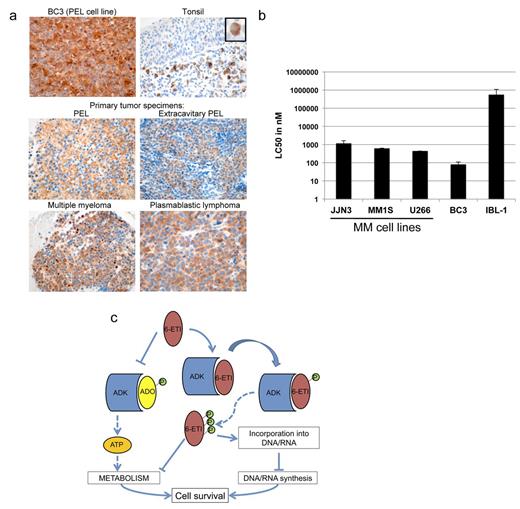Abstract
Primary effusion lymphoma (PEL) is a largely incurable malignancy of B cell origin, driven by infection with KSHV/HHV-8, and with notable plasmacytic differentiation. PEL carries an extremely poor prognosis with a median survival time of less than 6 months and is known to be largely resistant to conventional chemotherapy. Therefore, we conducted high throughput screens for effective inhibitors using PEL cell lines. We discovered a compound, 6-ethylthioinosine (6-ETI), a nucleoside analog with selective toxicity to PEL and multiple myeloma (MM) at nanomolar concentrations, but not to other lymphoma cell lines tested. 6-ETI also showed remarkable responses in a mouse xenograft model of PEL. To understand the molecular mechanism(s) of selectivity towards PEL, we developed and performed resistome analysis, an unbiased approach based on RNA sequencing of in vitro and in vivo generated resistant subclones. We found adenosine kinase (ADK) inactivating genomic alterations in all resistant clones as the mechanism of resistance. Concordantly, we found that plasma cells express ADK, as well as sensitive PELs and multiple myeloma cell lines, while resistant lymphoma cell lines including those with EBV infection had lower levels (if any); interestingly, the latter could be sensitized by cell crowding-induced ADK upregulation. Like other nucleoside analogues, 6-ETI induces ATP-depletion and cell death accompanied by S-phase arrest and DNA damage, but only in ADK-expressing cells. Immunohistochemistry for ADK served as a new biomarker approach to identify tumors that may be sensitive to 6-ETI, which we documented for primary specimens of PEL, multiple myeloma and other lymphoid malignancies with plasmacytic features, namely plasmablastic lymphoma. A number of nucleoside analogues have been reported to be effective in treating leukemias and B and T cell lymphomas. We performed structure-activity relationship studies and tested a number of nucleoside analogs that are in preclinical or clinical development for other hematological malignancies to identify and better understand the structural requirements for 6-ETIÕs biological activity. We successfully demonstrated that 6-ETI was more potent and selective at killing PEL and MM cell lines than other studied nucleoside analogs suggesting that this compound possesses unique and distinct features that are clinically promising. Despite the presence of treatment approaches that can greatly extended the survival of MM patients, resistance remains an issue, warranting the need for new effective agents and combinations. We identified 6-ETI as a novel and clinically viable nucleoside analog for the treatment of PEL, immunoblastic lymphoma, plasmablastic lymphoma, multiple myeloma and other ADK-expressing cancers.
Expression of ADK and sensitivity to 6-ETI in plasma cell tumors. (A) BC3 cells ADK expression was evaluated by immunohistochemistry in the BC3 cell line, hyperplastic tonsils and PEL, multiple myeloma and plasmablastic lymphoma primary tumors. 60X original magnification is shown. In the image of a tonsil section, a positive cell with morphological features of a plasma cell is enlarged in the insert. Original magnification 60X. (B) LC50s for multiple myeloma cell lines treated with 6-ETI were determined by CellTiter-Glo assay. BC3 was used as a positive control and IBL1 as a negative control for drug sensitivity. Shown are the average of two independent experiments, where each condition was performed in duplicate in each experiment. (C) Model for 6-ETIÕs mechanism of action within the cell is illustrated, where 6-ETI competes with adenosine (ADO) and other nucleosides for binding to and phosphorylation by ADK, which inhibits ATP-dependent metabolic processes. This also allows 6-ETI to be phosphorylated and activated by ADK, with subsequent phosphorylation steps that allow the compound to be incorporated into DNA and possibly RNA, leading to DNA synthesis inhibition, DNA damage response, and cell death.
Expression of ADK and sensitivity to 6-ETI in plasma cell tumors. (A) BC3 cells ADK expression was evaluated by immunohistochemistry in the BC3 cell line, hyperplastic tonsils and PEL, multiple myeloma and plasmablastic lymphoma primary tumors. 60X original magnification is shown. In the image of a tonsil section, a positive cell with morphological features of a plasma cell is enlarged in the insert. Original magnification 60X. (B) LC50s for multiple myeloma cell lines treated with 6-ETI were determined by CellTiter-Glo assay. BC3 was used as a positive control and IBL1 as a negative control for drug sensitivity. Shown are the average of two independent experiments, where each condition was performed in duplicate in each experiment. (C) Model for 6-ETIÕs mechanism of action within the cell is illustrated, where 6-ETI competes with adenosine (ADO) and other nucleosides for binding to and phosphorylation by ADK, which inhibits ATP-dependent metabolic processes. This also allows 6-ETI to be phosphorylated and activated by ADK, with subsequent phosphorylation steps that allow the compound to be incorporated into DNA and possibly RNA, leading to DNA synthesis inhibition, DNA damage response, and cell death.
Nayar:Weill Cornell Medical College: Patents & Royalties: Submitted patent applicatio for 6-ETI. Cesarman:Weill Cornell Medical College: Patents & Royalties: applied for patent for 6-ETI.
Author notes
Asterisk with author names denotes non-ASH members.


